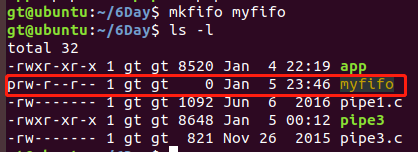FIFO
FIFO常被成为命名管道,以区分管道(pipe),管道(pipe)只能用于“有血缘关系”的进程间,但通过FIFO,不相关的进程也能交换数据。
FIFO是Linux基础文件类型中的一种,但是,FIFO文件在磁盘上没有数据块,仅仅用来标识内核中一条通道,各进程可以打开这个文件进行read/write,实际上是在读写内核通道,这样就实现了进程间通信。
使用方式:
命令:mkfifo 管道名
库函数:int mkfifo(const char *pathname, mode_t mode);成功返回0,失败返回-1
一旦使用mkfifo创建了一个FIFO,就可以使用open打开它,常见的文件I/O函数都可用于fifo,如:close,read,write,unlink等。
创建myfifo命名管道文件

写端:
#include <stdio.h>
#include <unistd.h>
#include <sys/stat.h>
#include <sys/types.h>
#include <fcntl.h>
#include <stdlib.h>
#include <string.h>
void sys_err(char *str)
{
perror(str);
exit(-1);
}
int main(int argc, char *argv[])
{
int fd, i;
char buf[4096];
if (argc < 2) {
printf("Enter like this: ./a.out fifoname\n");
return -1;
}
fd = open(argv[1], O_WRONLY);
if (fd < 0)
sys_err("open");
i = 0;
while (1) {
sprintf(buf, "hello itcast %d\n", i++);
write(fd, buf, strlen(buf));
sleep(1);
}
close(fd);
return 0;
}
读端:
#include <stdio.h>
#include <unistd.h>
#include <sys/stat.h>
#include <sys/types.h>
#include <fcntl.h>
#include <stdlib.h>
#include <string.h>
void sys_err(char *str)
{
perror(str);
exit(1);
}
int main(int argc, char *argv[])
{
int fd, len;
char buf[4096];
if (argc < 2) {
printf("./a.out fifoname\n");
return -1;
}
fd = open(argv[1], O_RDONLY);
if (fd < 0)
sys_err("open");
while (1) {
len = read(fd, buf, sizeof(buf));
write(STDOUT_FILENO, buf, len);
sleep(3); //多个读端时应增加睡眠秒数,放大效果.
}
close(fd);
return 0;
}